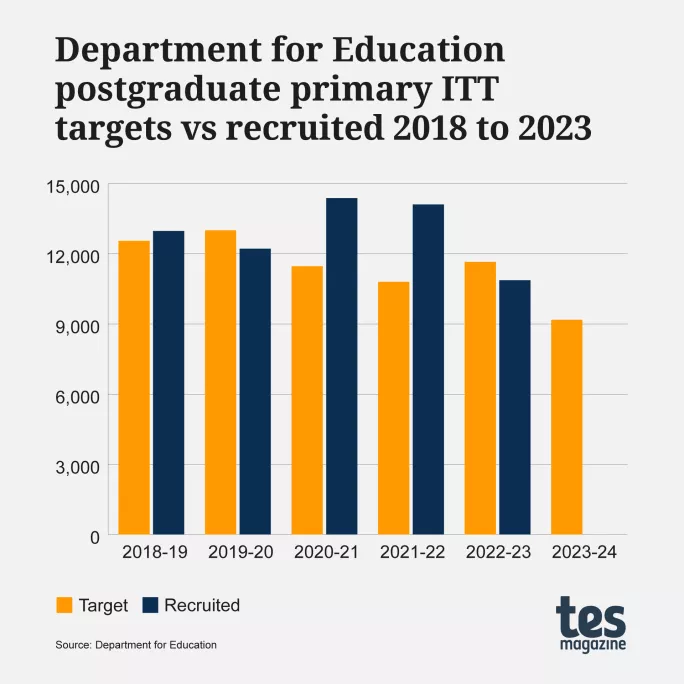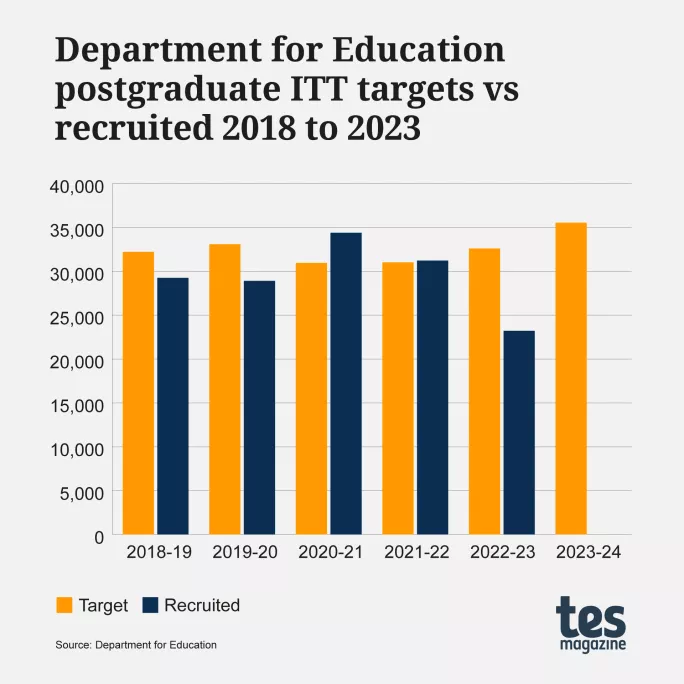DfE raises secondary ITT target by 26%

The Department for Education has hiked its recruitment target for secondary teacher trainees by 25.9 per cent this year, meaning thousands more entrants will be needed after two years of lower recruitment.
The government has estimated that 26,360 postgraduate initial teacher training (ITT) secondary trainees will need to start their training in the 2023-24 academic year in order to provide a sufficient supply of new teachers for 2024-25, up from 20,945 last year.
Experts are now forecasting that, based on applications so far, less than half of the secondary teachers that schools need will be recruited this year.
Despite a large increase in the secondary ITT entrant target, the DfE has decreased its target for primary trainee entrants by 21.2 per cent, falling from 11,655 in 2022-23 to 9,180 for 2023-24.



Trainee targets are published every year by the DfE and are estimated by looking at a number of factors, such as historic recruitment, retention and future need.
Last year, teacher trainee recruitment data was described as “catastrophic” by union leaders and experts called for “radical action” to fix the underlying problems with low pay and high workload in the teaching profession.
In 2022-23, the government missed its target for secondary teacher trainee entrants by 41 per cent, with just 12,356 entrants.
And last year, the government missed its primary trainee target for the first time since before the pandemic, and by the widest margin in eight years.
- Revealed: The ‘catastrophic’ drop in teacher trainee numbers
- ITT: Primary applications plummet by a fifth
- Recruitment crisis: DfE set to miss 2023-24 targets
Earlier this week, DfE data revealed that applications to primary ITT courses had fallen by almost a fifth year-on-year as experts warned of a “worrying” trend.
The DfE said that the primary target is lower this year partly due to recruitment and retention forecasts being “more favourable this year than last”.
Experts predict less than half of secondary teachers needed will be recruited
Reacting to the new targets, the National Foundation for Educational Research’s school workforce lead, Jack Worth, said: “The DfE’s published targets for this year’s ITT recruitment suggest even more new teachers will be required to meet schools’ future need for teachers compared to last year.
“The DfE now expects to need more trainees than last year in subjects that are already struggling to recruit the required numbers, which will further compound the challenge of ensuring an adequate supply.
“Our updated forecast for ITT recruitment this year, based on applications so far, shows we are now expecting to recruit less than half of the secondary teachers that schools need.
“We anticipate that all secondary subjects except history, Classics and PE will be below target this year. Without an urgent policy response to make teaching more attractive, schools will face increasingly intense shortages over the next few years, which are likely to impact negatively on the quality of education.”
Maths and English targets are up by more than 40%
Trainee targets increased across all but three secondary subjects for 2023-24.
Mathematics rose by 45.1 per cent to 2,960, up from 2,040 in 2022-23, while English rose by 44.5 per cent to 3,035, up from 2,100 last year.
The subject with the largest percentage increase in target is business studies, which increased by 560 trainees, from 635 to 1,195 (88.2 per cent increase).
And the English Baccalaureate subject with the largest percentage increase in target is geography, increasing by 540 trainees, from 945 to 1,485 (57.1 per cent increase).
Meanwhile, the target for modern foreign languages has been raised from 2,140 to 2,960, an increase of 38 per cent.
Targets have decreased for Classics, history and PE.
You need a Tes subscription to read this article
Subscribe now to read this article and get other subscriber-only content:
- Unlimited access to all Tes magazine content
- Exclusive subscriber-only stories
- Award-winning email newsletters
Already a subscriber? Log in
You need a subscription to read this article
Subscribe now to read this article and get other subscriber-only content, including:
- Unlimited access to all Tes magazine content
- Exclusive subscriber-only stories
- Award-winning email newsletters
topics in this article



